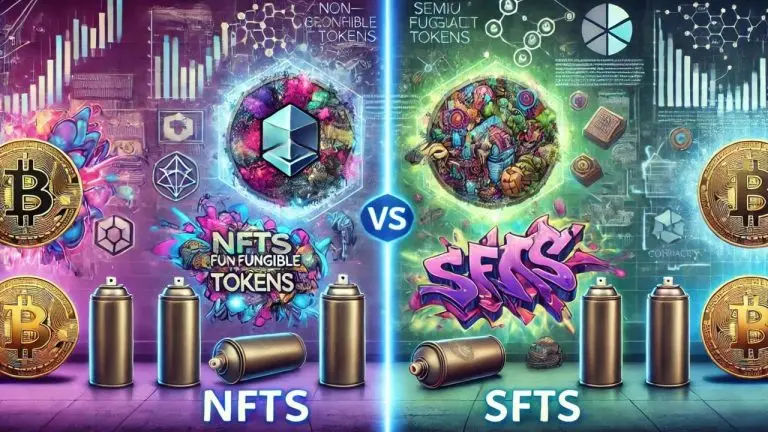As blockchain technology continues to evolve, various token standards have emerged, each serving unique purposes in the digital asset ecosystem. Among these, NFT (Non-Fungible Tokens) and SFT (Semi-Fungible Tokens) are two distinct types of blockchain-based assets gaining traction. While both offer exciting possibilities for creators and investors, they differ significantly in functionality, use cases, and flexibility.
This article explores the core differences between NFT and SFT, helping you understand their roles and potential applications.
Key Insights
- NFTs are unique, indivisible digital assets, ideal for art, collectibles, and virtual real estate. SFTs start as fungible tokens but transition to unique, non-fungible assets, offering versatility for use cases like event tickets and gaming rewards.
- NFTs are always non-fungible and static, while SFTs combine fungibility and non-fungibility, providing dynamic functionality for evolving assets.
- NFTs are Best suited for one-of-a-kind digital assets like art and metaverse spaces, while SFTs are Ideal for assets transitioning between states, such as tickets, gaming rewards, and limited-edition goods.
- NFTs are Expected growth in digital art, intellectual property, and fashion, while SFTs are Increasing use in gaming, ticketing, and supply chain management, enabling dynamic and efficient digital assets.
What Are NFT?
Non-fungible tokens (NFT), unique digital assets on the blockchain, are used to represent ownership rights over a certain item or content. Each NFT, unlike fungible (e.g. Bitcoin or Ethereum), is distinct and has a value.
Key Characteristics of NFT:
- Uniqueness: Each NFT has a unique serial number and cannot be substituted or exchanged one for the other.
- Indivisibility: The majority of NFTs are not divided into smaller items; they can only be bought, sold, or traded as a whole.
- Ownership Proof: NFTs provide a transparent record of ownership and provenance, ideal for digital art, collectibles, and intellectual property.
- Token Standard: NFTs are often built using the ERC-721 standard on Ethereum or similar protocols on other blockchains.
Common Use Cases for NFT:
- Digital Art: Artists tokenize their creations as NFTs to sell and track ownership.
- Gaming Assets: Unique in-game items like characters, skins, or weapons are represented as NFTs.
- Collectibles: NFTs are used to tokenize rare items like sports memorabilia and trading cards.
- Virtual Real Estate: Digital land and spaces in the metaverse are owned as NFTs.
What Are SFT?
Semi-fungible tokens (SFT) combine the properties of fungible and non-fungible tokens. They start as fungible assets, interchangeable with others of the same type, but can later transition into unique, non-fungible items.
Key Characteristics of SFT:
- Dual Nature: SFTs are fungible during certain phases (e.g., multiple copies of event tickets) but become non-fungible once used or customized (e.g., a redeemed ticket tied to a specific seat or event experience).
- Flexibility: SFTs allow creators to manage assets that need a mix of fungibility and uniqueness.
- Token Standard: SFTs often use the ERC-1155 standard, which supports both fungible and non-fungible functionalities.
Common Use Cases for SFT:
- Event Tickets: Tickets can be fungible when sold but become non-fungible after redemption, tied to a specific attendee or experience.
- Gaming Rewards: Tokens representing in-game currency can evolve into unique items as players progress.
- Limited-Edition Goods: Products with identical initial copies can become unique when linked to buyers or events.
NFT and SFT: Key Differences
| Feature | NFTs (Non-Fungible Tokens) | SFTs (Semi-Fungible Tokens) |
| Fungibility | Always unique and non-fungible | Starts as fungible and can transition to non-fungible |
| Flexibility | Static in nature | Combines fungibility and uniqueness |
| Token Standard | ERC-721 (or similar) | ERC-1155 (or similar) |
| Primary Use Cases | Digital art, collectibles, virtual real estate | Event tickets, gaming rewards, limited goods |
| Complexity | Simple ownership structure | Dynamic, with multiple states |
Benefits of NFT and SFT
Both token types have advantages that make them valuable in different scenarios:
Advantages of NFTs:
- Scarcity and Exclusivity: NFTs create unique digital assets with verifiable ownership.
- Cultural and Artistic Value: Ideal for digital art and collectibles with emotional or cultural significance.
- Simple Marketplace Dynamics: Buy, sell, or trade with clear ownership records.
Advantages of SFTs:
- Versatility: Combines fungibility and non-fungibility for complex use cases.
- Efficiency: Reduces the need for separate token standards when assets evolve.
- Dynamic Applications: Supports a wide range of industries, from gaming to ticketing.
When to Use NFT or SFT
The choice between NFTs vs. SFTs depends on your specific needs and goals:
- Use NFTs When:
- You need unique, one-of-a-kind items (e.g., digital art or collectibles).
- Ownership and scarcity are the primary focus.
- Use SFTs When:
- Assets transition from fungible to non-fungible states (e.g., tickets or gaming rewards).
- Flexibility and dual-purpose functionality are required.
Future Potential of NFT and SFT
Both NFTs and SFTs have transformative potential across industries:
- NFTs:
- Continued growth in digital art, metaverse real estate, and intellectual property.
- Expanding into sectors like fashion, music, and education.
- SFTs:
- Increasing adoption in gaming, ticketing, and supply chain management.
- Enhanced customization for dynamic digital assets.
The future of these tokens is intertwined, offering creators and businesses powerful tools to engage users and monetize digital experiences.
Conclusion
Understanding the differences between NFT and SFT is essential for navigating the evolving world of blockchain-based assets. While NFTs offer exclusivity and uniqueness, SFTs provide the flexibility to handle dynamic use cases that require a blend of fungibility and non-fungibility.
Both types of tokens have unique strengths and applications, empowering industries like gaming, art, and commerce. By choosing the right token type for your needs, you can unlock the full potential of blockchain technology and its transformative capabilities.
Whether you’re an investor, creator, or enthusiast, exploring the possibilities of NFTs and SFTs will help you stay ahead in the dynamic world of digital assets.
Follow Our Official Social Channels:
